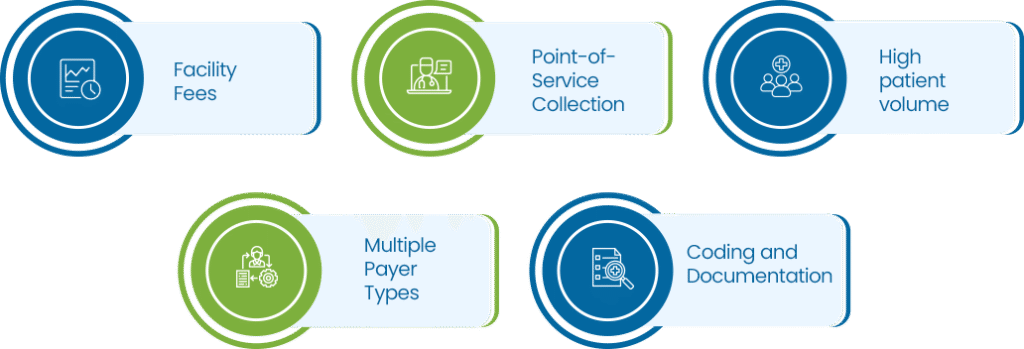Running an urgent care clinic is already a breakneck business; the patients walk in without scheduling a visit, the number of patients increases during flu seasons, and a provider can deal with sprained ankles to chest pain. To add to that, billing can be considered a second full-time job. The biggest struggle?
Claims are denied even with the provision of care that is delivered correctly due to the omission of details, use of incorrect place-of-service codes, or the payer regulations that appear to change overnight. This is increased paperwork, revenue delays, and frustration at the front desk for many providers. However, these obstacles can be transformed into seamless procedures with the appropriate billing information and applications. This guide simplifies urgent care billing and demonstrates how to properly document, code, and submit claims to ensure that your clinic is paid promptly, with fewer rejections.
What is an Urgent Care Facility?
An urgent care facility is a walk-in clinic for illnesses or injuries that demand immediate medical care, but are not a life-threatening emergency situation. Patients can visit urgent care without an appointment, even during evenings and weekends. The U.S. Centers for Medicare & Medicaid Services (CMS) defines an urgent care facility as a place that is not associated with a hospital emergency room or a routine doctor’s office, where patients arrive without a pre-set appointment to receive immediate medical care. That is, urgent care centers will fill the void between primary care doctors and hospital ERs by providing treatment for non-life-threatening conditions (such as minor injuries, infections, or flu) without the necessity of an appointment.
Basics of Urgent Care Billing
Following are the basic aspects of urgent care billing:
- Facility Fees: Unlike a regular doctor’s office, urgent care centers often charge a facility fee in addition to the doctor’s fee. This fee helps cover the clinic’s overhead costs (staff, equipment, extended hours).
- Point-of-Service Collections: Urgent care clinics usually collect payment at the time of service. Patients often pay a co-payment or coinsurance before leaving. Many urgent care centers even ask for full payment upfront if the patient is self-pay (i.e., no insurance). Collecting payments on the spot helps the urgent care avoid bad debt and keeps cash flow steady.
- Multiple Payer Types: The insurance plans that urgent care centers must accommodate include private insurance companies, Medicaid (state insurance to the low-income patients), Medicare (government insurance to the aged and the disabled), and out-of-pocket insurance plans, just to mention a few. The rate and regulations could vary based on the payer type in the mechanism of urgent care reimbursement.
Coding and Documentation: Proper coding (with the proper code of diagnosis and procedure) and adequate documentation are the goals in urgent care billing. The medical records should clearly indicate what and why was done because in many cases urgent care centers can perform both evaluation (examination) and operations (stitching a cut or X-ray).

Place of Service Codes (Urgent Care POS)
When filling out an insurance claim, medical providers must include a Place of Service (POS) code. This is a two-digit code that tells the insurer where the patient was seen (office, hospital, home, etc.). For urgent care billing, the special POS code is 20, which stands for “Urgent Care Facility.” This code (often called the urgent care POS code) was created by CMS to identify claims from urgent care centers.
CMS defines POS 20 – Urgent Care Facility as “a location, distinct from a hospital emergency room, an office, or a clinic, whose purpose is to diagnose and treat illness or injury for unscheduled, ambulatory patients seeking immediate medical attention.” In simpler terms, POS-20 is used for a walk-in urgent care clinic setting (not an ER or regular doctor’s office).
Using the correct POS code is very important for getting paid properly. Insurance companies process claims differently based on POS. Most insurers follow the CMS guideline that urgent care visits should be billed with POS-20, unless your contract with that insurer says to use a different code. For example, some insurance plans might treat an urgent care like a regular doctor’s office and expect POS-11 (office) on the claim. If you use the incorrect POS code, your claim may be denied or paid at an incorrect rate. In fact, if an urgent care is set up in an insurance company’s system as a physician office (POS-11), then sending a claim with POS-20 might get rejected.
Insurance and Urgent Care Reimbursement
Different payers handle urgent care billing in specific ways. Below is how Medicare, Medicaid, and private insurance generally work for urgent care, and what providers need to know:
- Medicare (Federal insurance for seniors and certain patients with disabilities): Medicare does not have distinct billing guidelines for urgent care, as opposed to routine outpatient care. Medicare patients’ bills for urgent care appointments are the same as those for regular office visits. You would utilize any procedure codes for treatments performed, as well as the regular evaluation and management (E/M) CPT codes (such as codes for new patients or established patient visits).
Medicare will not cover urgent care S-codes; S9083 and S9088 are not covered at all. Since those codes are not included in the standard CPT/HCPCS that Medicare utilizes for payment, Medicare actually does not recognize them. After the patient’s Part B deductible is satisfied, Medicare Part B normally pays 80% of the authorized cost of an urgent care visit; the remaining 20% must be paid by the patient or their secondary insurance. For urgent care appointments, Medicare patients typically additionally have to pay a fee, which is frequently comparable to the payment at a doctor’s office.
- Medicaid (State-run insurance for low-income individuals/families):
Medicaid programs differ depending on the state; however, the majority of them adhere to CMS rules like Medicare. It implies that urgent care services are charged on standard codes and the POS-20 code. Medicaid shall cover the urgent care treatment of covered patients when it is medically necessary. Most of the time, one does not need a referral to visit urgent care. Nonetheless, certain Medicaid plans (or Medicaid managed care organizations) may have certain stipulations, such as that the urgent care must be in-network or that some services have to be authorized.
The providers are advised to refer to their state Medicaid provider manual to get the directives on the billing of urgent care. Overall, urgent care visits should be covered by Medicaid and the payments will depend on the state fee schedule, which may be lower than Medicare or private insurance payments. However, like in the case of Medicare, no S-codes are submitted to Medicaid; refer to regular CPT codes in case of visits and procedures. - Private Insurance (Commercial insurers, employer plans):
Private insurance plans often encourage patients to use urgent care instead of the ER for non-emergencies, so they usually cover urgent care visits, often with a set urgent care co-pay (for example, $30 or $50) that the patient pays. Billing to private insurers will involve sending a claim (usually on a CMS-1500 form) with the appropriate codes.
Common Codes and Billing Procedures in Urgent Care
Understanding the codes used in urgent care billing is essential for accurate claims. Coding is the process of translating the services you provide into standardized codes that insurers recognize. There are two main types of codes to consider: diagnosis codes and procedure codes.
- Diagnosis Codes (ICD-10): These codes describe the underlying problem and the reason the patient presented. ICD-10-CM diagnosis codes are used in urgent care for illnesses such as S80.811A (abrasion on knee, first encounter), J06.9 (acute upper respiratory infection), etc. Precise diagnosis coding guarantees that the payer is aware of the visit’s medical necessity. Always use the most explicit code possible; if you are certain of the diagnosis, utilize it rather than a code that isn’t clear. For instance, instead of using a generic code for sore throat, use one for streptococcal pharyngitis if a patient has strep throat.
- Evaluation and Management (E/M) Codes: These CPT codes are more or less the duration of the office visit, and the complexity of the patient assessment. The urgent care centers and other outpatient clinics commonly use the Office or Other outpatient E/M codes. New patients (those who have not previously visited that urgent care facility or within 3 years; 99201 has been eliminated and is no longer used) are coded as 99202 through 99205.
Established patient codes (those who have attended that urgent care center within the last three years) are between 99211 and 99215. The code number depends on the complexity of the visit, the duration of the visit as well as the decisions that require a medical ruling. A more advanced review considering many themes can be coded as 99204 or 99214, etc., but a small problem can be coded as 99202 or 99212 (low-level). According to the documentation, the right level of choice is very important not to be too high (overcoding) or too low (undercoding).
- Urgent Care Specific Codes (S9088 & S9083): As mentioned in the insurance section, these are special HCPCS codes used mainly by certain private payers:
- S9088 – Services provided in an urgent care center, in addition to basic services. This is an add-on code. How to use it: If permitted by the insurer, you bill S9088 along with the E/M code for the visit (and any other procedure codes). It tells the payer that the service was provided at an urgent care facility.
- S9083 – Global fee for urgent care centers. This is a flat-rate code. How to use it: Only use S9083 if a payer requires it under your contract. When using S9083, you generally do not bill any other E/M or procedure codes for that visit (because S9083 is supposed to cover everything). The insurance will pay a single case-rate amount for the whole visit.
- S9088 – Services provided in an urgent care center, in addition to basic services. This is an add-on code. How to use it: If permitted by the insurer, you bill S9088 along with the E/M code for the visit (and any other procedure codes). It tells the payer that the service was provided at an urgent care facility.
- Procedure and Treatment Codes: Urgent care performs many minor procedures and tests. Each of these has its own CPT code. For example:
- Repairing a small cut with stitches – use a laceration repair CPT code based on wound length and location (e.g., code 12002 for suturing a small wound up to 2.5 cm on the body).
- Draining an abscess – use 10060 for a simple drainage of a skin abscess.
- Removing a splinter or foreign body – code 10120 for simple removal from under the skin.
- Applying a splint for a fracture – code 29105 for applying a forearm to hand splint.
- X-ray imaging – each X-ray has a code (e.g., 73080 for an elbow X-ray).
- Lab tests – e.g., 87804 for a rapid influenza test (flu swab) done in the clinic.
- Vaccines – e.g., 90732 for a pneumococcal vaccine given to an adult.
- Repairing a small cut with stitches – use a laceration repair CPT code based on wound length and location (e.g., code 12002 for suturing a small wound up to 2.5 cm on the body).
Providers don’t need to memorize all these codes, but they should be aware that whenever they perform a procedure or test, it must be coded and billed in addition to the visit/E/M code. Each service must be documented (with details like the size of a wound, the method of repair, results of tests, etc.) to support the CPT codes. Many urgent care providers use electronic medical record systems that help suggest the right codes based on documentation.
Avoiding Common Billing Pitfalls and Denials
Even when you know the basics, mistakes in urgent care billing can happen and lead to denials (claims not paid initially) or delayed payments. Here are common pitfalls to watch out for and how to prevent them:

- Missing or Incorrect Modifiers: As noted, forgetting the modifier (- 25) is a common mistake. If you perform a procedure and an E/M service in the same visit, don’t forget the -25 on the E/M code. Similarly, use -59 when needed for separate procedures. Always double-check your claim for required modifiers before submitting. A quick check can save a denial and rework.
- Inadequate Documentation: If the supporting documentation contradicts what was invoiced, insurance companies have the right to reject claims. For instance, the insurer may deny your claim if you billed for a complicated laceration repair but failed to specify the extent of the cut or its depth in your note. Another warning sign would be if you billed a high-level E/M code (like 99215) yet your documentation was really short. Ensure that every visit is thoroughly documented, including the patient’s history, primary complaint, examination results, test results, assessment, and treatment plan.
- Global Period Issues: Follow-up visits are part of the worldwide term (a window, such as 10 or 90 days, where normal follow-up is considered part of the original payment) for some treatments (such as stitching or repairing a fracture). Because the payer expects the follow-up to be free or included, invoicing another E/M visit for a patient that occurs during the global period of a procedure you conducted may result in refusal.
- Overcoding or Undercoding E/M Levels: Some providers might habitually code every visit at a high level (which is overcoding and can trigger audits), while others might undercode out of caution (which leaves money on the table). Both are problems. Use the actual visit complexity to choose the code. If you consistently code level 4 (99204/99214) for every encounter, ensure your notes truly support it.
- Lack of Awareness of Payer Rules: Every insurance can have unique quirks. For instance, some payers might require prior authorization for certain procedures even in urgent care (like maybe a joint injection or a high-cost medication). Others might deny a claim if a certain diagnosis code is billed without a specific lab test code. Stay informed of major payer policies. As a provider, you don’t need to know all the billing rules, but it helps to be generally aware.
- Incorrect Patient or Insurance Info: Many rejections are due to simple clerical errors. The payer’s system is likely to reject the claim altogether if the patient’s name, date of birth, insurance ID, or insurance provider information is input improperly. At check-in, ensure that the patient’s insurance information and demographics are up-to-date in the system. For instance, the claim will be sent to the incorrect company and rejected if the front desk fails to update the patient’s insurance, which changed this year. Checking eligibility on a regular basis can help identify these problems.
- Timely Filing Limits: Every insurance policy has a deadline for filing claims (which can range from 90 days to 180 days, etc., from the date of service). Urgent cares must submit their claims within these windows. A claim denied for late filing is usually not payable at all. To prevent this, have efficient billing workflows; claims should be submitted daily or at least weekly. Track any denials and resubmit or appeal quickly. Staying on top of the revenue cycle ensures you don’t accidentally miss the filing period.
Conclusion
Urgent care billing works best when your team focuses on a few simple things: write clear notes that show why the visit was needed, use the right diagnosis and procedure codes (and the right modifiers), put the correct place-of-service code on claims, check insurance and get prior authorization when required, and collect patient payments at the time of service when possible. Use your EHR and a payer rules list to help staff choose the right codes, train front-desk and clinical staff on common pitfalls, and track denials so you can address recurring issues. Do these things consistently, and you will reduce denials, get paid faster, and keep your urgent care running smoothly.

